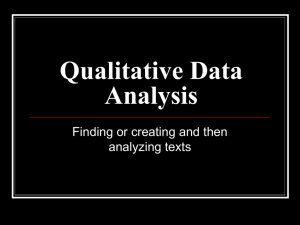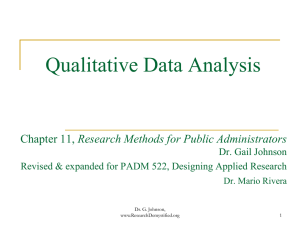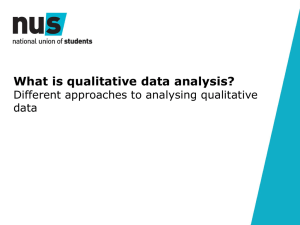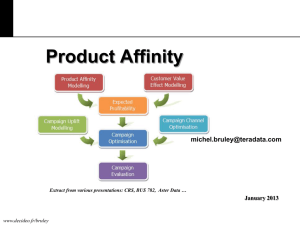Qualitative Research
advertisement
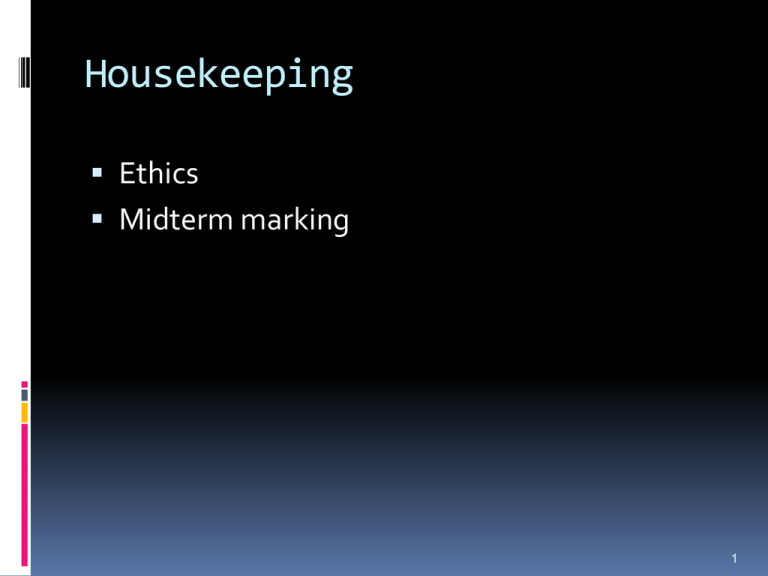
Housekeeping Ethics Midterm marking 1 QUALITATIVE ANALYSIS CODING (INTRO EXERCISES) QUALITY AND QUALITATIVE ANALYSIS AFFINITY DIAGRAMS THE QUALITATIVE ANALYTICAL PROCESS Qualitative Inquiry - Challenge To make sense of massive amounts of data, reduce the volume of information, identify significant patterns and construct a framework for communicating the essence of what the data reveal 2. The Procedures 1 Coding/indexing 2 Categorisation 3 Abstraction 4 Comparison 5 Dimensionalisation 6 Integration 7 Iteration 8 Refutation (subjecting inferences to scrutiny) 9 Interpretation (grasp of meaning - difficult to describe procedurally) Exercise 1 Coding with pre-defined categories Deductive analysis Theory Testing 6 Exercise 2 Open coding Inductive analysis Exploratory research Theory building research 7 Constant Comparison Each time you code data, compare it with other data to which you applied that code Can also compare with cases/examples from outside your data set (other research…) Similar to clustering algorithms… Similar to affinity diagrams (discussed later) 8 CONCEPT GENERATION & AFFINITY DIAGRAMS 9 The Science and Art of Qualitative Inquiry (Patton, 1988) The Science The scientific part is systematic, analytical, rigorous, disciplined, and critical in perspective The Art The artistic part is exploring, playful, metaphorical, insightful, and creative Critical Thinking ‘Critical Thinking calls for a persistent effort to examine any belief or supposed form of knowledge in the light of the evidence that supports it and the further conclusions to which it tends’ (Glaser, 1941) or more simply! Critical Thinking means weighting up the arguments and evidence for and against. Critical Thinking • Key points (Glaser, 1941): – Persistence: Considering an issue carefully and more than once – Evidence: Evaluating the evidence put forward in support of the belief or viewpoint – Implications: Considering where the belief or viewpoint leads; what conclusions would follow; are these suitable and rational; and if not, should the belief or viewpoint be reconsidered Guidance for Creative Thinking 1 2 3 4 5 6 7 8 9 Be open Generate options Divergence before convergence Use multiple stimuli - triangulate Side track, zig-zag, and circumnavigate Change patterns Make linkages Trust yourself Work and play at it The Credibility of Qualitative Analysis 1 Rigorous techniques and methods for gathering highquality data that is carefully analysed, with attention to issues of validity, reliability, and triangulation 2 The credibility of the researcher, which is dependent on training, experience, track record, status, and presentation of self 3 Philosophical belief in the phenomenological paradigm, that is, a fundamental appreciation of naturalistic inquiry, qualitative methods, inductive analysis and holistic thinking A Credible Qualitative Study The write-up for a credible qualitative study needs to address the following issues: 1 What techniques and methods were used to ensure the integrity, validity, and accuracy of the findings 2 What does the researcher bring to study in terms of qualifications, experience, and perspective 3 What paradigm orientation and assumptions ground the study Principles of Analysing Qualitative Data 1 Proceed systematically and rigorously (minimise human error) 2 Record process, memos, journals, etc. 3 Focus on responding to research questions 4 Appropriate level of interpretation appropriate for situation 5 Time (process of inquiry and analysis are often simultaneous) 6 Seek to explain or enlighten 7 Evolutionary/emerging Qualitative Research: Common Features of Analytic Methods (Miles & Huberman,1994) 1 Affixing codes to a set of field notes drawn from data collection 2 Noting reflections or other remarks in margin 3 Sorting or shifting through the materials to identify similar phrases, relationships between themes, distinct differences between subgroups and common sequences Qualitative Research: Common Features of Analytic Methods (Miles & Huberman,1994) 4 Isolating patterns and processes, commonalties and differences, and taking them out to the field in the next wave of data collection 5 Gradually elaborating a small set of generalisations that cover the consistencies discerned in the data base 6 Confronting those generalisations with a formalised body of knowledge in the from of constructs or theories Interface Design and Usability Engineering Goals: Articulate: •who users are •their key tasks Task centered system design Methods: Evaluate Brainstorm designs Psychology of everyday things Participatory design User involvement Usercentered design Representation & metaphors Participatory interaction Task / Cognitive scenario walk-through low fidelity prototyping methods Products: User and task descriptions Throw-away paper prototypes Refined designs Graphical screen design Interface guidelines Style guides Completed designs Usability testing Field testing Heuristic evaluation high fidelity prototyping methods Testable prototypes Alpha/beta systems or complete specification 19 brainstorming the point is: to generate MANY, WIDE-RANGING ideas nutty and absurd are GOOD. go for the extremes (to get out of the rut) riff off other’s ideas. the point is NOT: to generate excellent, complete, feasible ideas … pressure stifles to develop or critique ideas … go wide. deep is for later. process 1. prepare a list of topics / questions ahead of time; or in a preliminary brainstorm 2. facilitator takes team through list of topics switch topic when energy ramps down 3. notetaker takes notes (very important) 4. switch roles so everyone can play 5. ground rules 6. followup brainstorming is like popcorn ground rules Postpone and withhold your judgment of ideas: never criticize Encourage wild and exaggerated ideas Quantity counts at this stage, not quality Switch topics when the popcorn slows down Build on the ideas put forward by others Every person and every idea has equal worth Elect a facilitator (calls switches) and a notetaker Form groups of 8-10 assign a facilitator, note taker Problem: User interface for a car proximity detection system Brainstorm 3 aspects of the problem: (e.g., current problems, physical form factor, activity metaphor, input techniques, etc.) go: 5 minutes follow up collect the notes go through carefully, with judgment turned on look for interesting, surprising ideas that might work ideas that will combine well promising directions on which you should brainstorm more keep your notes. at a later design stage, come back to them and see if anything else has become useful in the meantime. work consolidation: abstracting specific insights one tool: the affinity diagram can use to “consolidate” insights from collected or generated data. for example: brainstorming about design problems categories of problems brainstorming about design ideas categories of ideas comments from users categories of desirable / successful features Qualitative analysis Another way to inductively determine appropriate codes ITSM Guidelines EXAMPLE Methodology (Phase I) HOT Admin findings (4 papers) Guidelines from literature (14 papers) Set of guidelines (164 guidelines) • Field studies • Field study: • Interviews • Participatory observation • Interviews • Questionnaires • Prototyping • Cognitive walkthroughs • Surveying other literature 28 Methodology (Phase I) HOT Admin publications (4 papers) Open Coding Guidelines from other literature (14 papers) Axial Coding Set of guidelines (164 guidelines) Categorized List of Guidelines 29 High level Category Low level Category Guideline Guideline ID number 30 Methodology (Phase I) Guidelines from other literature HOT Admin publications (4 papers) Open Coding (14 papers) Axial Coding Set of guidelines (164 guidelines) Card Sorting Guidelines Framework 31 Framework of Guidelines 32 how do you make an affinity diagram? 1. team writes down all data & insights on post-it notes; be sure you can link the post-it detail back to its source! 2. stick one post-it on the wall a whiteboard or big sheet of butcher paper is best 3. arrange the other post-its around it, grouping by affinity to each other. iteration will be required. 4. look at each group and see what it has in common; name and describe each group. 5. “snapshot” the result for documentation • digital photo your design website or notebook • transfer post-its onto xerox paper, 1 sheet / notes-cluster scan website why does an affinity diagram work? • use physical arrangement/proximity to understand connections • openness to serendipity • low cost to rearrange ideas • many variants: arrange along axes rather than by affinity tie causes to effects group evidence under assertions affinity diagram exercise Now take your notes from the earlier brainstorming and create an affinity diagram go: 8 minutes debrief





